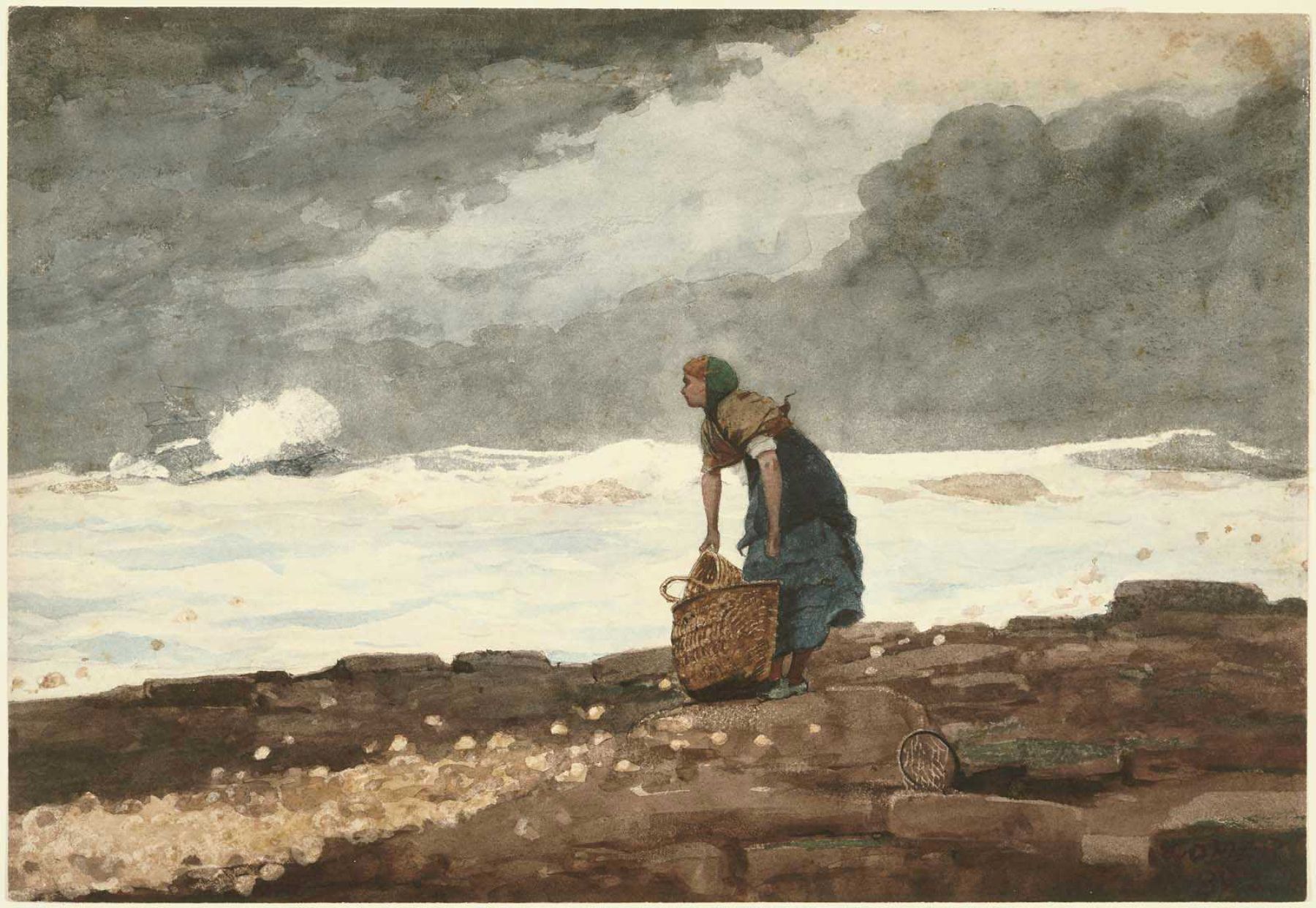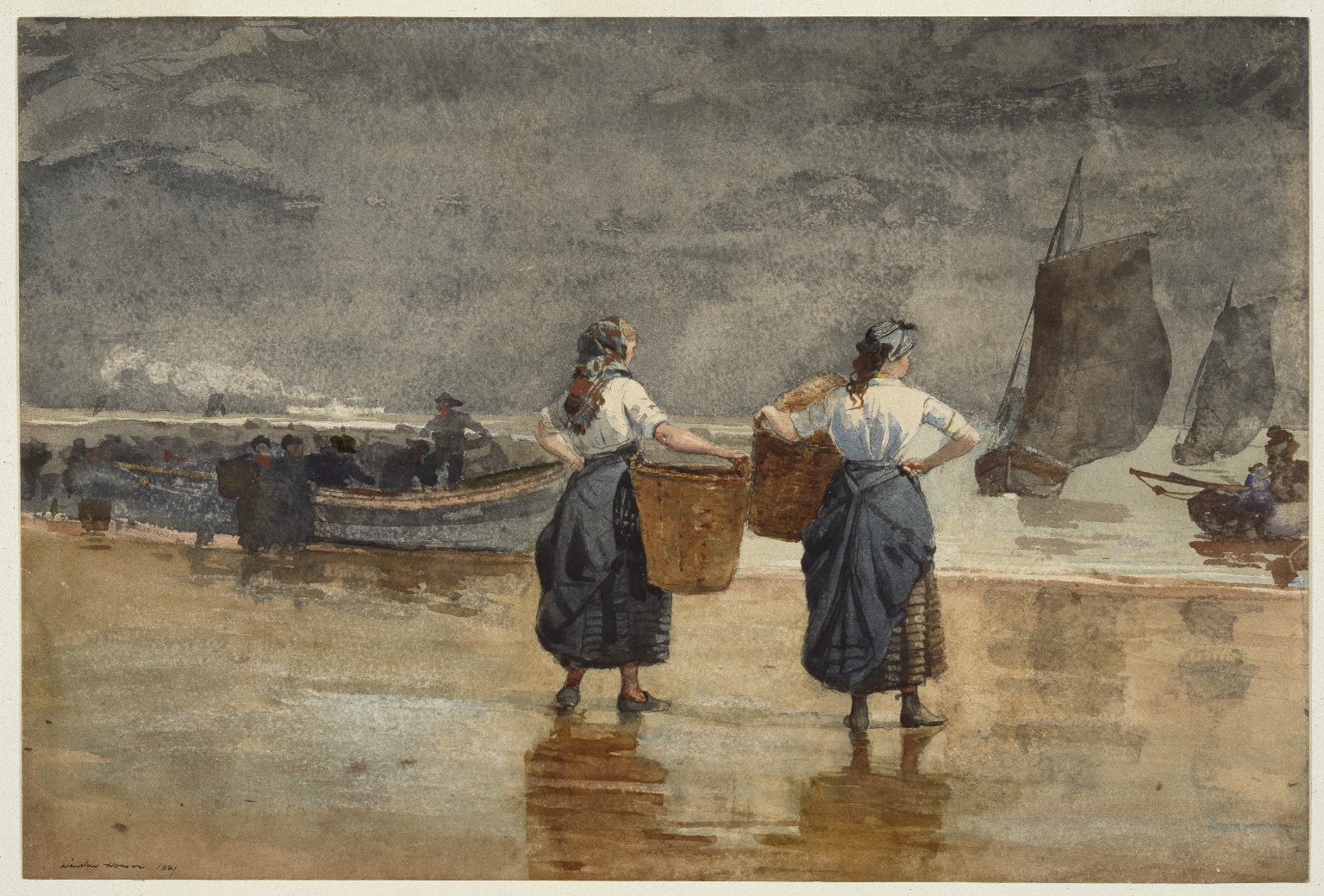History

Winslow Homer - Girl with Red Stockings (1882)
Our area has a rich heritage in basket making and basket use. In 1881, when the coble fishing industry was at its zenith, an American artist, Winslow Homer, visited Cullercoats and spent 18 months sketching and painting the local fisher girls. Most of this work shows girls with their baskets.
Later, in either 1922 or 1923, the cast of a school play of a Seahouses school were photographed wearing traditional fishwife's apparel holding creels. We are indebted to Jean Jackson (nee Smailes) for this photograph..
Recently, Northumbria Basketry Group member, Liz Balfour has started research into the history of baskets in Northumbria. Her first report entitled; "The Northumbrian Fishwife's Back Creel" was published in the February 2010 edition of The Basketmakers' Association Newsletter. It is reproduced below
The Northumbrian Fishwife's Back Creel
"This unusual basket first caught my eye 15 years ago at the Anstruther Fisheries Museum in Fife, Scotland and I had never seen anything like it before. At first glance it seemed to be part stake and strand, part frame basket but it was in a display, I was with my family, and it seemed we were not to be able to get to know each other better on that particular day.
I never forgot the basket and eventually tracked it (or one of its close relatives) down in a collection of photographs of the fisher folk of the Northumberland coast. There it was used by the woman of the household to carry the fish caught by her man from his small coble or fishing boat. The women wore traditional costume with skirts with rows of tucks in and an apron over the top, the men wore navy blue gansey jumpers knitted by the women.
In 2005 we moved to Northumberland for a couple of years and I was invited to give a talk to a WI group in Boulmer. Although this is really an RAF base, several of the group were able to tell me about the fishing life from their own experiences and ended by serenading me with the Cullercoats Fishwife's Song. I couldn't wait to find out more.
Then in June of last year I was basket making at Alnwick, a market town in North Northumberland (famous for it's Castle and Gardens) and another demonstrator told me I should visit the Ship Inn at Seahouses, on the coast, where a collection of fishing memorabilia including baskets hung in the bar.
At the first opportunity (August) I headed for this pub to find to my delight that there was a fishwife's creel hanging up in the ceiling with many other fishing items. It was a busy evening so I arranged with puzzled but helpful bar staff to come back in the morning to take photos and measure the basket.
By 11am in the morning it was a quieter spot and the cleaner kindly let me take the basket down and have a thorough look at it. Close to I could see that it was a frame basket with a wooden bar into which ribs of cane were inserted to start with and then the weaving continued in cane and more ribs were added in. I was able to take measurements and details of every aspect of construction and to see and photograph the many other items in the pub.
Then in October I was asked to give another talk in the county at a rural WI and one of the ladies there produced an even better version of this basket, very finely made but exactly the same shape and style. Two days later I gave a talk at Craster, a well known fishing village, to find that a local fisherman, Jack Browell, had sent along a basket for me to look at. This was a charming little frame gathering basket also made of cane.
I arranged to meet him later and he talked for a long time about his fishing career and life and of course about the baskets used. He suddenly started showing me how to make netting for a lobster pot (knitting he called it) and I hope to record him making a complete pot as he must be one of few who can do this now.

Winslow Homer - Fisher Girls on the Beach, Cullercoats (1881)
I also tracked down the local Poet who had recorded a great deal of information about the fishing way of life just as it was dying out and had saved some baskets herself including a small fishwife's creel made for a little girl.
The icing on the cake was to be sent a wonderful picture of a group of school girls who had been detailed to dress as fishwives and bring in baskets and outfits from home. This was from a childhood friend of one of the Northumbria Basketry Group who had since moved from the area while he had returned.
At the time the picture was taken fishing was still a going concern in the area and was a vital part of the local economy. Things have changed now and the highly efficient boats, nets and technology introduced since the war have meant it is so easy to track and catch fish that there aren't many left - certainly not enough to sustain the fishing communities.
These resilient people have found other ways to earn their living; there is a tourism industry, they take people out to the Farne Islands to see puffins and seals, there is some lobster and crab fishing and in Craster they smoke kippers.
Like so many traditional baskets the fishwife's creel has a simplicity and economy of design which make it beautiful and practical at the same time. It is a reminder of and a tribute to a vanished way of life in the fishing villages of Northumberland.
Note; cane was also used for the fishing baskets of the East Coast of Scotland and was preferred to any other material as the cane lasted much longer than willow or hazel especially when wet. The fishwife's baskets were constantly damp from the fish and from being scrubbed in between catches.
Cane comes from the Far East and I believe it was used as we would use packing tape nowadays to bale up the jute which came in from India. It was collected at the ports of the East Coast by itinerant basket makers.
Thanks to Jean Jackson and Katrina Porteous and Jack Browell and to the WI ladies of Boulmer, Craster and Glanton.

Fish Play at Seahouses School c.1922/3
Making a Northumbrian Fishwife’s Creel Frame
Following a decision to run a workshop making Northumbrian Fishwife’s Back Creels at the 2010 Basketmakers’ Association summer meeting Liz and Alan Winlow started to investigate the methods of making a creel to the Ship Inn design.
Alan was involved with making the wooden frames for the creel. Instructions for making these have now been drafted as below :
A workshop to revive the making of Northumbrian Fishwife’s Back Creels organised by Liz Balfour at the Rothbury Summer Meeting created a lot of interest with no less than 20 people taking part. A sturdy wooden frame creates the required form for the creel. Set out below is a description of how the frames were made:
The timber selected was a 6” by 2” nominal joinery quality redwood from a local timber merchant. The length of each frame blank was 20.5 inches. It was necessary to check the quality of the pieces carefully for excessive knots and cracks. A 12mm plywood jig was made to enable the curve of the frame to be replicated easily. The jig was carefully marked out with the positions of the holes in the frame. As we were using willow rods to create the form of the basket the holes had to be drilled large enough for the butts on one side and the tips of the rods on the other. With experience we found that the two hole sizes chosen, 8mm and 12mm, were of a suitable size for the 8 foot willow rods used. To give balance to the weaving the holes were drilled alternately – in the first row the large hole was on the left and the small on the right, in the second row the situation was reversed with the small hole on the left and so on. The location of the holes running horizontally through the frame was marked by lines on the jig. These lines were used to mark the location for these holes on each frame. Finally four lines were marked out, the first was one inch from the top of the frame at the end of each arm of the frame and the other two were two inches in from the end of the arms on the lower side. These lines were used to cut a triangular fillet of wood from the underside of each arm.
A jigsaw was used to cut out the waste wood between the two arms. The two triangular fillets of wood were sawn off and the length of wood between the two arms was then rounded using a reciprocating saw. At this point the holes were drilled in the frame using a pillar drill. The eight holes in the square section of the frame were drilled vertically in one direction and at an angle of 14 degrees in the other. (This gives the basket its characteristic curve away from the frame) To get the angle the frame was supported by a 14 degree wedge on the pillar drill platform. The four holes in the arms were more complex – the two outer ones were at 14 degrees in both planes and the inner two were 14 degrees in one direction and 7 degrees in the other. Again wedges were used on the pillar drill platform to get the desired angles.The two horizontal holes through the frame were drilled with an electric drill fitted with a long 8mm drill. To ensure that the holes were horizontal a spirit level was taped to the electric drill. Then the frame was levelled and the holes drilled with the drill held in the horizontal position.
To finish, more wood was removed from the frame with a Surform Plane and a rough file was used to round the corners of the frame. A final sanding with a drum sander gave the frame its sea-smoothed feel and a coat of Georgian Light Oak wood stain was used to darken the wood to a close match with the willow.
If anyone requires further details, a plywood jig or a frame please contact Alan Winlow at info@northumbriabasketrygroup.co.uk or 01669 621650.
Liz meanwhile investigated the weaving of the creel. The results of her efforts can be seen in the attached video created by Paul Paxton for a news item in the BBC Look North programme. The video clip shows Liz supported by Alan making creels on the quay at Amble harbour. The piece was broadcast on Look North on Wednesday 21st July 2010.